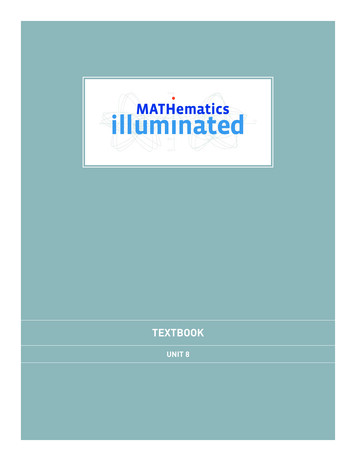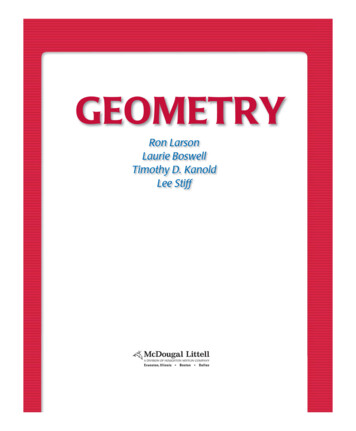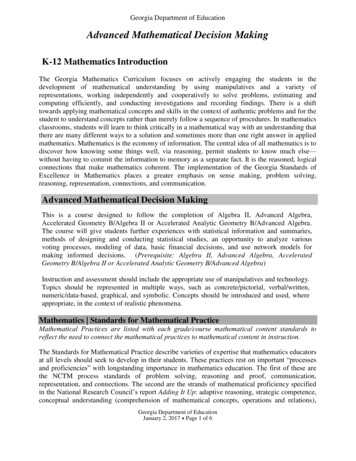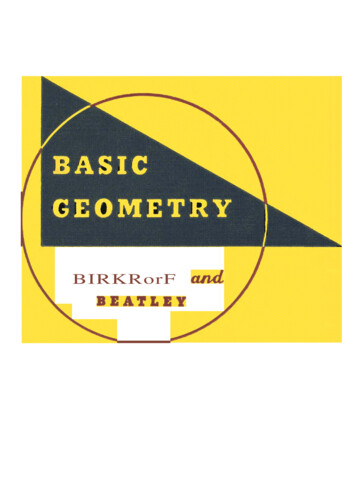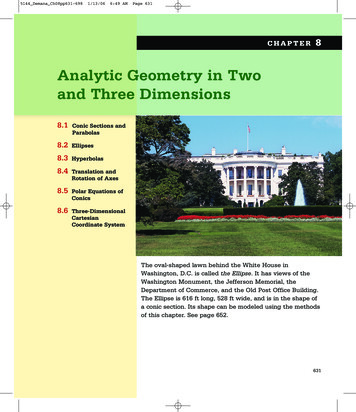
Transcription
5144 Demana Ch08pp631-6981/13/066:49 AMPage 631CHAPTER8Analytic Geometry in Twoand Three Dimensions8.1Conic Sections andParabolas8.2Ellipses8.3Hyperbolas8.4Translation andRotation of Axes8.5Polar Equations ofConics8.6Three-DimensionalCartesianCoordinate SystemThe oval-shaped lawn behind the White House inWashington, D.C. is called the Ellipse. It has views of theWashington Monument, the Jefferson Memorial, theDepartment of Commerce, and the Old Post Office Building.The Ellipse is 616 ft long, 528 ft wide, and is in the shape ofa conic section. Its shape can be modeled using the methodsof this chapter. See page 652.631
5144 Demana Ch08pp631-6986321/13/066:49 AMPage 632CHAPTER 8 Analytic Geometry in Two and Three DimensionsHISTORY OF CONIC SECTIONSChapter 8 OverviewParabolas, ellipses, and hyperbolas hadbeen studied for many years whenApollonius (c. 262–190 B.C.) wrote hiseight-volume Conic Sections.Apollonius, born in northwestern AsiaMinor, was the first to unify thesethree curves as cross sections of a coneand to view the hyperbola as havingtwo branches. Interest in conic sections was renewed in the 17th centurywhen Galileo proved that projectilesfollow parabolic paths and JohannesKepler (1571–1630) discovered thatplanets travel in elliptical orbits.Analytic geometry combines number and form. It is the marriage of algebra and geometry that grew from the works of Frenchmen René Descartes (1596–1650) and Pierrede Fermat (1601–1665). Their achievements allowed geometry problems to be solvedalgebraically and algebra problems to be solved geometrically—two major themes ofthis book. Analytic geometry opened the door for Newton and Leibniz to develop calculus.In Sections 8.1–8.4, we will learn that parabolas, ellipses, and hyperbolas are all conicsections and can all be expressed as second-degree equations. We will investigate theiruses, including the reflective properties of parabolas and ellipses and how hyperbolasare used in long-range navigation. In Section 8.5, we will see how parabolas, ellipses,and hyperbolas are unified in the polar-coordinate setting. In Section 8.6, we will movefrom the two-dimensional plane to revisit the concepts of point, line, midpoint, distance, and vector in three-dimensional space.8.1Conic Sections and ParabolasWhat you’ll learn about Conic Sections Geometry of a Parabola Translations of Parabolas Reflective Property of aParabolaConic SectionsImagine two nonperpendicular lines intersecting at a point V. If we fix one of thelines as an axis and rotate the other line (the generator) around the axis, then thegenerator sweeps out a right circular cone with vertex V, as illustrated in Figure 8.1.Notice that V divides the cone into two parts called nappes , with each nappe of thecone resembling a pointed ice-cream cone. . . and whyAxisConic sections are the paths ofnature: Any free-moving objectin a gravitational field followsthe path of a conic section.GeneratorUppernappeVLowernappeFIGURE 8.1 A right circular cone (of two nappes).A conic section (or conic ) is a cross section of a cone, in other words, the intersectionof a plane with a right circular cone. The three basic conic sections are the parabola, theellipse, and the hyperbola (Figure 8.2a).Some atypical conics, known as degenerate conic sections , are shown in Figure 8.2b.Because it is atypical and lacks some of the features usually associated with an ellipse,
5144 Demana Ch08pp631-6981/13/066:49 AMPage 633SECTION 8.1 Conic Sections and ParabolasOBJECTIVEStudents will be able to find the equation,focus, and directrix of a parabola.633a circle is considered to be a degenerate ellipse. Other degenerate conic sections can beobtained from cross sections of a degenerate cone; such cones occur when the generator and axis of the cone are parallel or perpendicular. (See Exercise 73.)MOTIVATEAsk students if all parabolas are similar(in the geometric sense). (Yes)LESSON GUIDEDay 1: Conic Sections; Geometry of aParabolaDay 2: Translations of Parabolas;Reflective Property of a ParabolaBIBLIOGRAPHYFor students: Practical Conic Sections,J. W. Downs. Dale Seymour , Carl Sagan and Ann Druyan.Ballentine Books, 1997.For teachers: Astronomy: From the Earthto the Universe (5th ed.),J. M. Pasachoff. Saunders CollegePublishing, 1998.Multicultural and Gender Equity in theMathematics Classroom: The Gift ofDiversity (1997 Yearbook), JanetTrentacosta (Ed.) National Council ofTeachers of Mathematics, 1997.Posters:Conic Sections. Dale SeymourPublicationsLocating Satellites in Elliptical Orbits,National Council of Teachers ofMathematicsPoint: plane throughcone's vertex onlySingle line: planetangent to coneIntersecting lines(b)FIGURE 8.2 (a) The three standard types of conic sections and (b) three degenerate conicsections.TEACHING NOTESYou may wish to construct the nappe of acone by rolling up a piece of paper inorder to illustrate various conic sectionsas cross sections of a cone.Note that a circle is a special case of anellipse and thus considered a degenerateconic.The conic sections can be defined algebraically as the graphs of second-degree(quadratic) equations in two variables, that is, equations of the formAx 2 Bxy Cy 2 Dx Ey F 0,where A, B, and C are not all zero.
5144 Demana Ch08pp631-6986341/13/066:49 AMPage 634CHAPTER 8 Analytic Geometry in Two and Three DimensionsGeometry of a ParabolaIn Section 2.1 we learned that the graph of a quadratic function is an upward or downward opening parabola. We have seen the role of the parabola in free-fall and projectile motion. We now investigate the geometric properties of parabolas.A DEGENERATE PARABOLAIf the focus F lies on the directrix l, theparabola “degenerates” to the linethrough F perpendicular to l.Henceforth, we will assume F does notlie on l.LOCUS OF A POINTBefore the word set was used in mathematics, the Latin word locus, meaning“place,” was often used in geometricdefinitions. The locus of a point wasthe set of possible places a point couldbe and still fit the conditions of thedefinition. Sometimes, conics are stilldefined in terms of loci.DEFINITION ParabolaA parabola is the set of all points in a plane equidistant from a particular line (thedirectrix ) and a particular point (the focus ) in the plane. (See Figure 8.3.)The line passing through the focus and perpendicular to the directrix is the (focal) axisof the parabola. The axis is the line of symmetry for the parabola. The point where theparabola intersects its axis is the vertex of the parabola. The vertex is located midwaybetween the focus and the directrix and is the point of the parabola that is closest toboth the focus and the directrix. See Figure 8.3.TEACHING NOTEPoint on the parabolaExercise 71 explains how Figure 8.3 wascreated, and this exercise can be usedinstead of (or in addition to) Exploration 1.Dist. to directrixDist. to focusAxisFocusEXPLORATION EXTENSIONSVertexFind the y-coordinate for a point on theparabola that is a distance of 25 unitsfrom the focus. Ans. 24Directrixy(0, 1)xFIGURE 8.3 Structure of a Parabola. The distance from each point on the parabola to boththe focus and the directrix is the same.EXPLORATION 1Understanding the Definition of Parabola1. Prove that the vertex of the parabola with focus 0, 1 and directrixy 1 is 0, 0 . (See Figure 8.4.)2. Find an equation for the parabola shown in Figure 8.4. x2 4yFIGURE 8.4 The geometry of a parabola.3. Find the coordinates of the points of the parabola that are highlighted inFigure 8.4.
5144 Demana Ch08pp631-6981/13/066:49 AMPage 635SECTION 8.1 Conic Sections and Parabolas635We can generalize the situation in Exploration 1 to show that an equation for the parabola with focus 0, p and directrix y p is x 2 4py. (See Figure 8.5.)yyDirectrix: y –pFocus F(0, p)x2 4pypP(x, y)xVertex at originpDirectrix: y –pALERTNote that the standard form of the equation of an upward or downward openingparabola is not the same as the standardform of a quadratic function.D(x, –p)FocuslThe vertex lieshalfway betweendirectrix and focus.(a)xx2 4pyF(0, p)(b)FIGURE 8.5 Graphs of x2 4py with (a) p 0 and (b) p 0.We must show first that a point P(x, y) that is equidistant from F(0, p) and the liney p satisfies the equation x2 4py, and then that a point satisfying the equationx2 4py is equidistant from F(0, p) and the line y p:Let P(x, y) be equidistant from F(0, p) and the line y p. Notice that x 0 2 y p 2 distance from P x, y to F 0, p , and x x 2 y p 2 distance from P x, y to y p.Equating these distances and squaring yields: x 0 2 y p 2 x x 2 y p 2x 2 y p 2 0 y p 2x 2 y 2 2py p 2 y 2 2py p2x 2 4pySimplify.Expand.Combine like terms.By reversing the above steps, we see that a solution x, y of x 2 4py is equidistantfrom F 0, p and the line y p.The equation x 2 4py is the standard form of the equation of an upward or downward opening parabola with vertex at the origin. If p 0, the parabola opens upward; ifp 0, it opens downward. An alternative algebraic form for such a parabola is y ax 2,where a 1 4p . So the graph of x 2 4py is also the graph of the quadratic functionf x ax 2.NAME GAMEAdditional features of a parabola aredefined in Exercises 74–76. The focalwidth is the length of the latus rectum.When the equation of an upward or downward opening parabola is written as x 2 4py,the value p is interpreted as the focal length of the parabola—the directed distancefrom the vertex to the focus of the parabola. A line segment with endpoints on a parabolais a chord of the parabola. The value 4p is the focal width of the parabola—thelength of the chord through the focus and perpendicular to the axis.
5144 Demana Ch08pp631-6986361/13/066:49 AMPage 636CHAPTER 8 Analytic Geometry in Two and Three DimensionsParabolas that open to the right or to the left are inverse relations of upward or downward opening parabolas. So equations of parabolas with vertex 0, 0 that open to theright or to the left have the standard form y 2 4px. If p 0, the parabola opens to theright, and if p 0, to the left. (See Figure 8.6.)yy2 4pxDirectrix:x –pVertexParabolas with Vertex (0, 0)FocusOxF(p, 0)(a)yy2 4pxDirectrix:x –px 2 4pyy 2 4px OpensUpward ordownwardTo the right orto the left Focus 0, p p, 0 Directrixy px p Axisy-axisx-axis Focal lengthpp Focal width 4p 4p See Figures 8.5 and 8.6.VertexFocusF(p, 0) Standard equationOxEXAMPLE 1Finding the Focus, Directrix,and Focal WidthFind the focus, the directrix, and the focal width of the parabola y 1 2 x 2.(b)FIGURE 8.6 Graph of y2 4pxwith (a) p 0 and (b) p 0.SOLUTION Multiplying both sides of the equation by 2 yields the standard formx 2 2y. The coefficient of y is 4p 2, and p 1 2. So the focus is 0, p 0, 1 2 . Because p 1 2 1 2, the directrix is the line y 1 2. Thefocal width is 4p 2 2.Now try Exercise 1.EXAMPLE 2NOTES ON EXAMPLESWhen solving a problem such as Example2, students should be strongly encouragedto draw a sketch of the given information.You may wish to draw a sketch for thestudents to model this behavior.Finding an Equation of a ParabolaFind an equation in standard form for the parabola whose directrix is the line x 2and whose focus is the point 2, 0 .SOLUTION Because the directrix is x 2 and the focus is 2, 0 , the focal lengthis p 2 and the parabola opens to the left. The equation of the parabola in standardform is y 2 4px, or more specifically, y 2 8x.Now try Exercise 15.Translations of ParabolasWhen a parabola with the equation x 2 4py or y 2 4px is translated horizontally byh units and vertically by k units, the vertex of the parabola moves from 0, 0 to h, k .(See Figure 8.7.) Such a translation does not change the focal length, the focal width,or the direction the parabola opens.
5144 Demana Ch08pp631-6981/13/066:49 AMPage 637SECTION 8.1 Conic Sections and Parabolas637yy(h, k p)(h p, k)TEACHING NOTE(h, k)(h, k)Students should be able to relate the transformations of parabolas (and other conicsections) to the transformations that werestudied beginning in Section 1.5.xx(b)(a)FIGURE 8.7 Parabolas with vertex h, k and focus on (a) x h and (b) y k.Parabolas with Vertex (h, k) Standard equation x h 2 4p y k y k 2 4p x h OpensUpward ordownwardTo the right orto the left Focus h, k p h p, k Directrixy k px h p Axisx hy k Focal lengthpp Focal width 4p 4p See Figure 8.7.EXAMPLE 3 Finding an Equation of a ParabolaFind the standard form of the equation for the parabola with vertex (3, 4) and focus(5, 4).SOLUTION The axis of the parabola is the line passing through the vertex 3, 4 and the focus 5, 4 . This is the line y 4. So the equation has the form y k 2 4p x h .Because the vertex h, k 3, 4 , h 3 and k 4. The directed distance from thevertex 3, 4 to the focus 5, 4 is p 5 3 2, so 4p 8. Thus the equation weseek is y 4 2 8 x 3 .Now try Exercise 21.
5144 Demana Ch08pp631-6986381/13/066:49 AMPage 638CHAPTER 8 Analytic Geometry in Two and Three DimensionsWhen solving a problem like Example 3, it is a good idea to sketch the vertex, thefocus, and other features of the parabola as we solve the problem. This makes it easyto see whether the axis of the parabola is horizontal or vertical and the relative positions of its features. Exploration 2 “walks us through” this process.EXPLORATION 2Building a ParabolaCarry out the following steps using a sheet of rectangular graph paper.1. Let the focus F of a parabola be 2, 2 and its directrix be y 4. DrawEXPLORATION EXTENSIONSCheck your work by using a grapher tograph the equation you found in step 8.the x- and y-axes on the graph paper. Then sketch and label the focus anddirectrix of the parabola.2. Locate, sketch, and label the axis of the parabola. What is the equation ofthe axis?3. Locate and plot the vertex V of the parabola. Label it by name and coordi-nates.4. What are the focal length and focal width of the parabola?5. Use the focal width to locate, plot, and label the endpoints of a chord ofthe parabola that parallels the directrix.6. Sketch the parabola.7. Which direction does it open? downward8. What is its equation in standard form? (x 2)2 12(y 1)Sometimes it is best to sketch a parabola by hand, as in Exploration 2; this helps us seethe structure and relationships of the parabola and its features. At other times, we maywant or need an accurate, active graph. If we wish to graph a parabola using a functiongrapher, we need to solve the equation of the parabola for y, as illustrated in Example 4.EXAMPLE 4 Graphing a ParabolaUse a function grapher to graph the parabola y 4 2 8 x 3 of Example 3.SOLUTION y 4 2 8 x 3 y 4 8 x 3 y 4 8 x 3 Extract square roots.Add 4.Let Y1 4 8 x 3 and Y2 4 8 x 3 , and graph the two equations ina window centered at the vertex, as shown in Figure 8.8.Now try Exercise 45.
5144 Demana Ch08pp631-6981/13/066:49 AMPage 639SECTION 8.1 Conic Sections and Parabolas639CLOSING THE GAPIn Figure 8.8, we centered the graphing window at the vertex (3, 4) of theparabola to ensure that this pointwould be plotted. This avoids the common grapher error of a gap betweenthe two upper and lower parts of theconic section being plotted.[–1, 7] by [–2, 10]FIGURE 8.8 The graphs of Y1 4 8 (x 3) and Y2 4 8 (x 3)together form the graph of y 4 2 8 x 3 . (Example 4)EXAMPLE 5 Using Standard Forms with a ParabolaProve that the graph of y 2 6x 2y 13 0 is a parabola, and find its vertex,focus, and directrix.SOLUTION Because this equation is quadratic in the variable y, we complete thesquare with respect to y to obtain a standard form.Filament(light source)at focusggointOut of lighsyary 2 6x 2y 13 0y 2 2y 6x 13y 2 2y 1 6x 13 1 y 1 2Isolate the y-terms.Complete the square. 6x 12 y 1 2 6 x 2 This equation is in the standard form y k 2 4p x h , where h 2, k 1,and p 6 4 3 2 1.5. It follows that the vertex h, k is 2, 1 ;SEARCHLIGHT(a)Parabolic radiowave reflector the focus h p, k is 3.5, 1 , or 7 2, 1 ; the directrix x h p is x 0.5, or x 1 2.nalso sig sidag r t focuminaInco entratecnocNow try Exercise 49.Reflective Property of a ParabolaThe main applications of parabolas involve their use as reflectors of sound, light, radiowaves, and other electromagnetic waves. If we rotate a parabola in three-dimensionalspace about its axis, the parabola sweeps out a paraboloid of revolution. If we placea signal source at the focus of a reflective paraboloid, the signal reflects off the surfacein lines parallel to the axis of symmetry, as illustrated in Figure 8.9a. This property isused by flashlights, headlights, searchlights, microwave relays, and satellite up-links.RADIO TELESCOPE(b)FIGURE 8.9 Examples of parabolicreflectors.The principle works for signals traveling in the reverse direction as well; signals arrivingparallel to a parabolic reflector’s axis are directed toward the reflector’s focus. This property is used to intensify signals picked up by radio telescopes and television satellite dishes, to focus arriving light in reflecting telescopes, to concentrate heat in solar ovens, andto magnify sound for sideline microphones at football games. See Figure 8.9b.
5144 Demana Ch08pp631-6986401/13/066:49 AMPage 640CHAPTER 8 Analytic Geometry in Two and Three Dimensionsy(–1.5, 1)EXAMPLE 6 Studying a Parabolic MicrophoneOn the sidelines of each of its televised football games, the FBTV network uses a parabolic reflector with a microphone at the reflector’s focus to capture the conversationsamong players on the field. If the parabolic reflector is 3 ft across and 1 ft deep, whereshould the microphone be placed?(1.5, 1)F(0, p)V(0, 0)xSOLUTIONWe draw a cross section of the reflector as an upward opening parabola in theCartesian plane, placing its vertex V at the origin (see Figure 8.10). We let the focusF have coordinates 0, p to yield the equationFIGURE 8.10 Cross section ofparabolic reflector in Example 6.x 2 4py.Because the reflector is 3 ft across and 1 ft deep, the points 1.5, 1 must lie on theparabola. The microphone should be placed at the focus, so we need to find the valueof p. We do this by substituting the values we found into the equation:FOLLOW-UPAsk students to explain why parabolicmirrors are used in flashlights.x 4pyASSIGNMENT GUIDE( 1.5)2 4p(1)Day 1: Ex. 1, 5–19 odds, 31–32, 37, 40, 57Day 2: Ex. 3, 21–54 multiples of 3, 59, 612.25 4pCOOPERATIVE LEARNINGp 2.25 4 0.5625Group Activity: Ex. 63–64Because p 0.5625 ft, or 6.75 inches, the microphone should be placed inside thereflector along its axis and 6.75 inches from its vertex.Now try Exercise 59.NOTES ON EXERCISESEx. 59–64 are applications of parabolas.Ex. 65–70 provide practice for standardized tests.Ex. 74–76 are quite challenging and couldbe used for a group project.ONGOING ASSESSMENTSelf-Assessment: Ex. 1, 15, 21, 45, 49, 59Embedded Assessment: Ex. 57–58QUICK REVIEW 8.1(For help, go to Sections P.2, P.5, and 2.1.)In Exercises 1 and 2, find the distance between the given points.31. 1, 3 and 2, 5 1 2. 2, 3 and a, b In Exercises 3 and 4, solve for y in terms of x.3. 2y 2 8x y 2 x 4. 3y 2 15x y 5 xIn Exercises 5 and 6, complete the square to rewrite the equation invertex form.5. y x 2 2x 76. y 2x 2 6x 5In Exercises 7 and 8, find the vertex and axis of the graph of f.Describe how the graph of f can be obtained from the graph ofg(x) x2, and graph f.7. f x 3 x 1 2 58. f x 2x 2 12x 1In Exercises 9 and 10, write an equation for the quadratic functionwhose graph contains the given vertex and point.9. Vertex 1, 3 , point 0, 1 f(x) 2(x 1)2 310. Vertex 2, 5 , point 5, 13 f(x) 2(x 2)2 5
5144 Demana Ch08pp631-6981/13/066:49 AMPage 641SECTION 8.1 Conic Sections and Parabolas641SECTION 8.1 EXERCISES26. Vertex (3, 5), directrix y 7 (x 3)2 8(y 5)In Exercises 1–6, find the vertex, focus, directrix, and focal width ofthe parabola.1. x 2 6y3. y 2 227. Vertex (2, 1), opens upward, focal width 1628. Vertex ( 3, 3), opens downward, focal width 202. y 2 8x 4 x 3 4. x 5. 3x 2 4y4 229. Vertex ( 1, 4), opens to the left, focal width 10 6 y 1 30. Vertex (2, 3), opens to the right, focal width 56. 5y 2 16xIn Exercises 31–36, sketch the graph of the parabola by hand.In Exercises 7–10, match the graph with its equation.y31. y 2 4xy33. x 4 232. x 2 8y 12 y 1 34. y 2 2 16 x 3 35. y 1 2 8 x 3 xx36. x 5 2 20 y 2 In Exercises 37–48, graph the parabola using a function grapher.39. x 8y 2138. y x 2640. x 2y 241. 12 y 1 x 3 242. 6 y 3 x 1 243. 2 y 16 x 3 244. x 4 2 6 y 1 37. y 4x 2(a)(b)yy45. (y 3)2 12(x 2)46. (y 1)2 4(x 5)47. (y 2)2 8(x 1)xx(c)(d)7. x 2 3y (c)9. y 2 5x (a)8. x 2 4y (b)10. y 2 10x (d)In Exercises 11–30, find an equation in standard form for the parabolathat satisfies the given conditions.In Exercises 49–52, prove that the graph of the equation is a parabola,and find its vertex, focus, and directrix.49. x 2 2x y 3 051.12. Vertex (0, 0), focus (0, 2)y250. 3x 2 6x 6y 10 0 4y 8x 20 052. y 2 2y 4x 12 0In Exercises 53–56, write an equation for the parabola.53.11. Vertex (0, 0), focus ( 3, 0) y2 12xx248. (y 6)2 16(x 4)54.yy(5.5, 0)(0, 2) 8yxx(1, –3)(–6, –4)13. Vertex (0, 0), directrix y 4 x2 16y14. Vertex (0, 0), directrix x 2 y2 8x15. Focus (0, 5), directrix y 5 x2 20y16. Focus ( 4, 0), directrix x 4 y2 16x55.56.yy17. Vertex (0, 0), opens to the right, focal width 8 y2 8x18. Vertex (0, 0), opens to the left, focal width 12 y2 12x(–1, 3)19. Vertex (0, 0), opens downward, focal width 6 x2 6y20. Vertex (0, 0), opens upward, focal width 3 x2 3y(3, 5)x(2, –1)(0, –2)21. Focus ( 2, 4), vertex ( 4, 4) (y 4)2 8(x 4)22. Focus ( 5, 3), vertex ( 5, 6) (x 5)2 12(y 6)23. Focus (3, 4), directrix y 1 (x 3)2 6(y 5/2)24. Focus (2, 3), directrix x 5(y 3)2 6(x 7/2)25. Vertex (4, 3), directrix x 6 (y 3)2 8(x 4)57. Writing to Learn Explain why the derivation of x2 4py isvalid regardless of whether p 0 or p 0.58. Writing to Learn Prove that an equation for the parabola withfocus (p, 0) and directrix x p is y2 4px.
5144 Demana Ch08pp631-6986421/13/066:49 AMPage 642CHAPTER 8 Analytic Geometry in Two and Three Dimensions59. Designing a Flashlight Mirror The mirror of a flashlight is aparaboloid of revolution. Its diameter is 6 cm and its depth is 2 cm.How far from the vertex should the filament of the light bulb beplaced for the flashlight to have its beam run parallel to the axisof its mirror?64. Group Activity Designing a Bridge Arch Parabolic archesare known to have greater strength than other arches. A bridgewith a supporting parabolic arch spans 60 ft with a 30-ft wideroad passing underneath the bridge. In order to have a minimumclearance of 16 ft, what is the maximum clearance?6 cm2 cm60. Designing a Satellite Dish The reflector of a televisionsatellite dish is a paraboloid of revolution with diameter 5 ft and adepth of 2 ft. How far from the vertex should the receivingantenna be placed?60 ft30 ft5 ftThe maximum clearance is about 21.33 feet.2 ftStandardized Test Questions61. Parabolic Microphones TheSports Channel uses a parabolicmicrophone to capture all thesounds from golf tournamentsthroughout a season. If one of itsmicrophones has a parabolic surface generated by the parabolax2 10y, locate the focus (theelectronic receiver) of theparabola.65. True or False Every point on a parabola is the same distancefrom its focus and its axis. Justify your answer.66. True or False The directrix of a parabola is parallel to theparabola’s axis. Justify your answer.In Exercises 67–70, solve the problem without using a calculator.67. Multiple Choice Which of the following curves is not a conicsection? D(A) circle62. Parabolic Headlights Stein Glass, Inc., makes parabolicheadlights for a variety of automobiles. If one of its headlightshas a parabolic surface generated by the parabola x2 12y, whereshould its light bulb be placed?63. Group Activity Designing a Suspension Bridge Themain cables of a suspension bridge uniformly distribute theweight of the bridge when in the form of a parabola. The maincables of a particular bridge are attached to towers that are 600 ftapart. The cables are attached to the towers at a height of 110 ftabove the roadway and are 10 ft above the roadway at their lowestpoints. If vertical support cables are at 50-ft intervals along thelevel roadway, what are the lengths of these vertical cables?(B) ellipse(C) hyperbola(D) oval(E) parabola68. Multiple Choice Which point do all conics of the formx2 4py have in common? D(A) (1, 1)(B) (1, 0)(C) (0, 1)(D) (0, 0)(E) ( 1, 1)69. Multiple Choice The focus of y2 12x is B(A) (3, 3).110 ft50 ft(B) (3, 0).(C) (0, 3).(D) (0, 0).600 ft(E) ( 3, 3).
5144 Demana Ch08pp631-6981/13/066:49 AMPage 643SECTION 8.1 Conic Sections and Parabolas70. Multiple Choice The vertex of (y 3)2 8(x 2) is D(A) (3, 2).(B) ( 3, 2).(C) ( 3, 2).(D) ( 2, 3).64373. Degenerate Cones and Degenerate Conics Degeneratecones occur when the generator and axis of the cone are parallelor perpendicular.(a) Draw a sketch and describe the “cone” obtained when the generator and axis of the cone are parallel.(E) ( 2, 3).(b) Draw sketches and name the types of degenerate conicsobtained by intersecting the degenerate cone in part (a) with aplane.Explorations(c) Draw a sketch and describe the “cone” obtained when the generator and axis of the cone are perpendicular.71. Dynamically Constructing a Parabola Use a geometrysoftware package, such as Cabri Geometry II , The Geometer’sSketchpad , or similar application on a handheld device toconstruct a parabola geometrically from its definition. (SeeFigure 8.3.)(a) Start by placing a line l (directrix) and a point F (focus) not onthe line in the construction window.(b) Construct a point A on the directrix, and then thesegment AF.(c) Construct a point P where the perpendicular bisector of AFmeets the line perpendicular to l through A.(d) What curve does P trace out as A moves? parabola(e) Prove your answer to part (d) is correct.72. Constructing Points of a Parabola Use a geometry software package, such as Cabri Geometry II , The Geometer’sSketchpad , or similar application on a handheld device, to construct Figure 8.4, associated with Exploration 1.(a) Start by placing the coordinate axes in the constructionwindow.(b) Construct the line y 1 as the directrix and the point 0, 1 as the focus.(c) Construct the horizontal lines and concentric circles shown inFigure 8.4.(d) Construct the points where these horizontal lines and concentric circles meet.(e) Prove these points lie on the parabola with directrix y 1and focus 0, 1 .(d) Draw sketches and name the types of degenerate conicsobtained by intersecting the degenerate cone in part (c) with aplane.Extending the Ideas74. Tangent Lines A tangent line of a parabola is a line thatintersects but does not cross the parabola. Prove that a line tangentto the parabola x 2 4py at the point a, b crosses the y-axis at 0, b .75. Focal Chords A focal chord of a parabola is a chord of theparabola that passes through the focus.(a) Prove that the x-coordinates of the endpoints of a focal chordm2 1 , where m is the slopeof x 2 4py are x 2p m of the focal chord.(b) Using part (a), prove the minimum length of a focal chord isthe focal width 4p .76. Latus Rectum The focal chord of a parabola perpendicular tothe axis of the parabola is the latus rectum , which is Latin for“right chord.” Using the results from Exercises 74 and 75, prove:(a) For a parabola the two endpoints of the latus rectum and thepoint of intersection of the axis and directrix are the verticesof an isosceles right triangle.(b) The legs of this isosceles right triangle are tangent to theparabola.
5144 Demana Ch08pp631-6986441/13/066:49 AMPage 644CHAPTER 8 Analytic Geometry in Two and Three Dimensions8.2EllipsesWhat you’ll learn aboutGeometry of an Ellipse Geometry of an Ellipse Translations of EllipsesWhen a plane intersects one nappe of a right circular cylinder and forms a simpleclosed curve, the curve is an ellipse. Orbits and Eccentricity Reflective Property of anEllipseDEFINITION Ellipse. . . and whyAn ellipse is the set of all points in a plane whose distances from two fixed pointsin the plane have a constant sum. The fixed points are the foci (plural of focus) ofthe ellipse. The line through the foci is the focal axis . The point on the focal axismidway between the foci is the center . The points where the ellipse intersects itsaxis are the vertices of the ellipse. (See Figure 8.11.)Ellipses are the paths of planets and comets around the Sun,or of moons around planets.OBJECTIVEStudents will be able to find the equation,vertices, and foci of an ellipse.VertexFocusCenterFocusFigure 8.12 shows a point P x, y of an ellipse. The fixed points F1 and F2 are the fociof the ellipse, and the distances whose sum is constant are d1 and d2. We can constructan ellipse using a pencil, a loop of string, and two pushpins. Put the loop around thetwo pins placed at F1 and F2, pull the string taut with a pencil point P, and move thepencil around to trace out the ellipse (Figure 8.13).We now use the definition to derive an equation for an ellipse. For some constants aand c with a c 0, let F1 c, 0 and F2 c, 0 be the foci (Figure 8.14). Then anellipse is defined by the
Analytic geometry combines number and form. It is the marriage of algebra and geom-etry that grew from the works of Frenchmen René Descartes (1596–1650) and Pierre de Fermat (1601–1665). Their achievements allowed geometry problems to be solved algebraically and algebra problems to be solved geom



